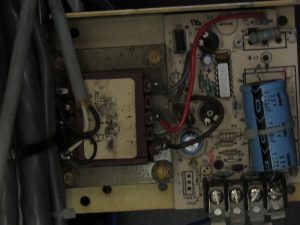Introduction to Transformer Theory and Ratios
Transformer theory describes how a transformer steps voltage up or down in AC (alternating current) circuits. On a transformer, we have primary windings, and secondary windings. The primary winding induces a voltage into the secondary windings that is proportional to the number of windings in the primary vs. the secondary.
The reason a transformer only works with AC is that it requires the electromagnetic field to continuously be moving (expanding and contracting). This is similar to how a generator works at a power plant. There are 3 requirements to induce electricity: A magnetic field, a conductor, and relative motion. Because the magnetic field in a transformer is continuously expanding and contracting, we meet all three of these requirements. We induce a voltage into the secondary winding.
Here, we see a power supply circuit with a 5:1 transformer. The transformer is the component on the left half of the image.

Ratios in Transformer Theory
A 2:1 transformer refers to the ratio between the number of windings in the primary vs. the number of windings in the secondary. This will also tell us what the voltage will be in the secondary winding if we know the voltage applied to the primary. In a 2:1 transformer, the voltage in the secondary will be half of that in the secondary. On a 10:1 transformer, the voltage in the secondary winding will be 1/10th the voltage of the primary winding. If you have a 1:10 transformer, then the voltage steps up, so the secondary voltage will be 10 times higher than the primary winding.
You will also find 1:1 transformers. These transformers do not step up or step down voltage. We call them “isolation transformers”. They isolate the voltage source of the primary from the load on the secondary. We use this to filter out DC, and for instances where the ground potentials of the source and load are different.
Reversing a Transformer
Physically, you can reverse a transformer. For example, we have a step down transformer, which has the ration of 5:1. Let’s say we need to step the voltage up instead of down. You might think that we could just turn the transformer around. The problem with this is in the design of the transformer. Typically, the design of the secondary is low impedance. This is to reduce losses. This means that if you reverse the transformer, you might have too much current flow in what was initially the secondary winding. Also, be aware of the voltage ratings.
You could be stepping up the voltage to a level that the insulation can not handle. On the other hand, let’s say you accidentally wire a transformer backwards. This will likely damage your circuit. Instead of stepping the voltage down, you step it up. This means that instead of getting 24 volts out, you get 600 volts. Always be aware of the dangers associated with transformers.
Industrial Uses for Transformer Theory
In many industrial machines, we supply equipment with 480 volts (three phase). We must reduce this to 120 volts or even 24 volts to supply industrial processors or other low voltage equipment. The transformer simply connects to two of the three phases of the supply to create single phase, low voltage power. We can connect one leg to ground if a floating ground is not desired.
Preservation
Aside from losses, power is preserved in a transformer. Let’s consider a 5:1 transformer that is supplied by 120v. The secondary voltage will be 24v. Recall from our power calculations post, that P=VI. We can manipulate this algebraically, and I=P/V. Let’s assume that our load on the 24v side is using 120 watts. Since 120/24 = 5, we will have 5 amps on the secondary. On the primary, we are still pulling roughly 120 watts, but the voltage is 120 volts. This means that on the primary side, we will pull only 1 amp. This is why a power supply that you purchase might be able to supply 10 Amps, but only has a 2 or 3 amp fuse on the supply (primary) side.
Warning: Always use the proper safety precautions when working with high voltage. Transformers can produce a voltage that is much higher than the input.
If you wish to have on-site industrial training, visit my employer’s website at atifortraining.com!
— Ricky Bryce
